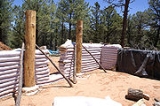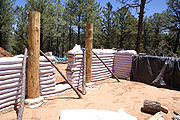
Super Adobe
Encyclopedia

Earthbag construction
Earthbag construction is an inexpensive method to create structures which are both strong and can be quickly built. It is a natural building technique that evolved from historic military bunker construction techniques and temporary flood-control dike building methods...
that was developed by Iranian architect Nader Khalili
Nader Khalili
Nader Khalili was an Iranian-born architect, writer, and humanitarian who received his philosophical and architectural education in Iran, Turkey, and the United States....
. The technique uses layered long fabric tubes or bags filled with adobe
Adobe
Adobe is a natural building material made from sand, clay, water, and some kind of fibrous or organic material , which the builders shape into bricks using frames and dry in the sun. Adobe buildings are similar to cob and mudbrick buildings. Adobe structures are extremely durable, and account for...
to form a compression structure. The resulting beehive shaped structures employs arches, domes, and vaults to create single and double-curved shells that are strong and aesthetically pleasing. It has received growing interest for the past two decades in the Natural building
Natural building
A natural building involves a range of building systems and materials that place major emphasis on sustainability. Ways of achieving sustainability through natural building focus on durability and the use of minimally processed, plentiful or renewable resources, as well as those that, while...
and Sustainability
Sustainability
Sustainability is the capacity to endure. For humans, sustainability is the long-term maintenance of well being, which has environmental, economic, and social dimensions, and encompasses the concept of union, an interdependent relationship and mutual responsible position with all living and non...
movements.
History
Although it is not known exactly how long, Earth bag shelters have been used for decades, primarily as implements of refuge in times of war. Military infantrymen have used sand filled sacks to create bunkers and barriers for protection prior to World War I. In the last century other earthbag buildings have undergone extensive research and are slowly beginning to gain worldwide recognition as a plausible solution to the global epidemic of housing shortages.German architect Frei Otto
Frei Otto
Frei Paul Otto is a German architect and structural engineer.- Life :Otto was born in Siegmar . He studied architecture in Berlin before being drafted into the Luftwaffe as a fighter pilot in the last years of World War II...
is said to have experimented with earth bags, as is more recently Gernot Minke. The technique’s current pioneer is Nader Khalili
Nader Khalili
Nader Khalili was an Iranian-born architect, writer, and humanitarian who received his philosophical and architectural education in Iran, Turkey, and the United States....
who originally developed the Superadobe system in 1984 in response to a NASA
NASA
The National Aeronautics and Space Administration is the agency of the United States government that is responsible for the nation's civilian space program and for aeronautics and aerospace research...
call for housing designs for future human settlements on the Moon and on Mars. His proposal was to use moon dust to fill the plastic Superadobe tubes and Velcro together the layers (instead of barbed wire).
Some projects have been done using bags as low-tech foundations for Straw-bale construction
Straw-bale construction
Straw-bale construction is a building method that uses bales of straw as structural elements, building insulation, or both...
. They can be covered in a waterproof membrane to keep the straw dry.
In 1995 15 refugee shelters were built in Iran, by Nader Khalili and the United Nations Development Programme
United Nations Development Programme
The United Nations Development Programme is the United Nations' global development network. It advocates for change and connects countries to knowledge, experience and resources to help people build a better life. UNDP operates in 177 countries, working with nations on their own solutions to...
(UNDP) and the United Nations High Commissioner for Refugees
United Nations High Commissioner for Refugees
The Office of the United Nations High Commissioner for Refugees , also known as The UN Refugee Agency is a United Nations agency mandated to protect and support refugees at the request of a government or the UN itself and assists in their voluntary repatriation, local integration or resettlement to...
(UNHCR) in response to refugees from the Persian Gulf War. According to Khalili the cluster of 15 domes that was built could have been repeated by the thousands. The government dismantled the camp a few years later.
Since then, the Super Adobe Method has been put to use in Canada, Mexico, Brazil, Belize, Costa Rica, Chile, Iran, India, Siberia, Mali, and Thailand, as well as in the U.S.
Materials
Many different materials can be used to construct Superadobe. Ideally you would have barbed wire, earth or sand, cement or lime, and Superadobe polypropylene tubing (available from Cal-Earth); bags can be polypropylene, or burlap. What is important is that they are UV resistant or else quickly covered in plaster. Virtually any fill material will actually work including un-stabilized sand, earth, gravel, crushed volcanic rock, rice hulls, etc. If the fill material is weak the bags have to be really strong and UV resistant, or else plastered right away. The material can be either wet or dry, but the structure is more stable when the tube's contents have been moistened. Other materials needed include, water, shovels, tampers, scissors, large plugs or pipes (for windows), and small buckets or coffee cans for filling the sacks. If you decide to go the quicker way, then electric or pneumatic tampers can make the tamping easier, electric or gas powered bucket chain that can reach 7m or higher would eliminate the need of manual filling of sacks or tubing using coffee cans or small pails.Process
The foundation for the structure is formed by digging a 12” (approx. 30 cm) deep circular trench with a 8’-14’ (approx. 2 to 4m) diameter. Two or three layers of the filled polypropylene sand tubes (Superadobe tubing) are set below the ground level in the foundation trench. A chain is anchored to the ground in the center of the circle and used like a compass to trace the shape of the base. Another chain is fastened just outside the dome wall: this is the fixed or height compass and gives you the interior measurement for every single layer of superadobe bags as they corbel ever higher. The height compass is exactly the diameter of the dome. The center chain/compass is used to ensure the accuracy of each new superadobe layer as it is laid and tamped. (The compasses must be made of non-stretchy material to ensure an accurate geometry.)On top of each layer of tamped, filled tubes, a tensile loop of barbed wire is placed to help stabilize the location of each consecutive layer: it plays a crucial role in the tensile strength of the dome - it is the 'mortar'. Window voids can be placed in several ways: either by rolling the filled tube back on itself around a circular plug (forming an arched header) or by waiting for the earth mixture to set and sawing out a Gothic or pointed arch void. A round skylight can even be the top of the dome.
It is not recommended to exceed the 14’ (4m) diameter design in size, but many larger structures have been created by grouping several "beehives" together to form a sort of connected village of domes. Naturally this lends itself to residential applications, some rooms being for sleeping and some for living. There is a 32' (10m) dome being constructed in the St. Ignacio area of Belize, which when finished will be the centre dome of an eco-resort complex.
Finishing
Once the corbelled dome is complete, it can be covered in several different kinds of exterior treatments, usually plaster. Khalili developed a system that used 85% earth and 15% cement plaster and which is then covered by “Reptile”, a veneer of grapefruit sized balls of cement and earth. Reptile is easy to install and because the balls create easy paths for stress, it doesn't crack with time. There are many different possibilities. Some Superadobe buildings have even been covered by living grass, a kind of Green roofGreen roof
A green roof is a roof of a building that is partially or completely covered with vegetation and a growing medium, planted over a waterproofing membrane. It may also include additional layers such as a root barrier and drainage and irrigation systems...
but covering the entire structure. Any exterior treatment and building details would need to be adapted to a region’s specific climatic needs.
Emergency shelters
According to Khalili's website, in an emergency, impermanent shelters can be built using only dirt with no cement or lime, and for the sake of speed of construction windows can be punched out later due to the strength of the compressive nature of the dome/beehive. Ordinary sand bags can also be used to form the dome if no Superadobe tubes can be procured; this in fact was how the original design was developed. There is a great potential for long-term emergency shelters with Superadobe because of the simplicity of construction. Labor can be unskilled and high physical strength or formal training is unnecessary for the workers, so women and children are able to substantially contribute to the construction process. Local resources can be used with ease. Superadobe is not an exact art and similar materials may be substituted if the most ideal ones are not readily available.In an interview with an AIA (American Institute of Architects) representative, Nader Khalili, super adobe’s founder and figurehead said this about the emergency shelter aspects of Superadobe: “A 400 square feet (37.2 m²) house, with bedroom, bathroom, kitchen, and entry — I call it the Eco-Dome — can be put up in about four weeks, by one skilled and four unskilled people. Emergency shelters can go up much more quickly. After the Gulf War, the United Nations sent an architect here. We trained him, and he went to the Persian Gulf and put them up with refugees as they arrived at the camps. Every five incoming refugees put up a simple structure in five days. It's emergency shelter, but if you cover it with waterproofing and stucco
Stucco
Stucco or render is a material made of an aggregate, a binder, and water. Stucco is applied wet and hardens to a very dense solid. It is used as decorative coating for walls and ceilings and as a sculptural and artistic material in architecture...
, it will last for 30 or more years.”
External links
- http://calearth.org/building-designs/what-is-superadobe.html Khalili's site describing his explanation of his method which he names "Superadobe", not "Super Adobe".
- earthbagbuilding.com - Includes many photos of Superadobe projects.

